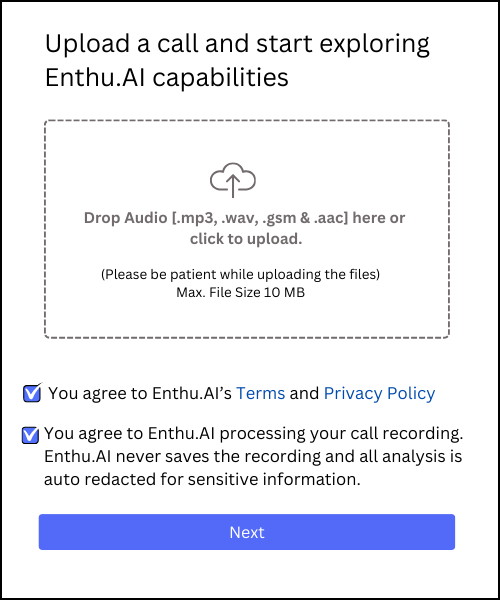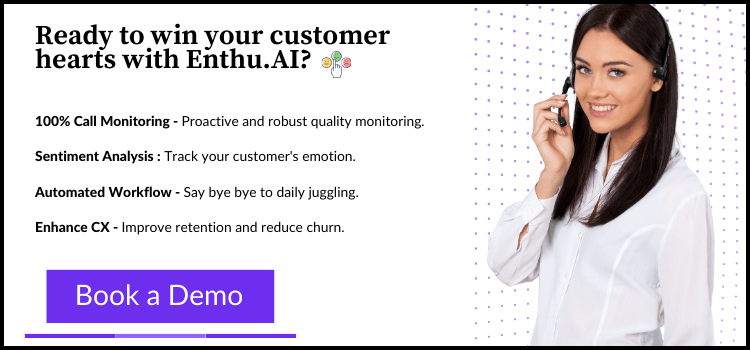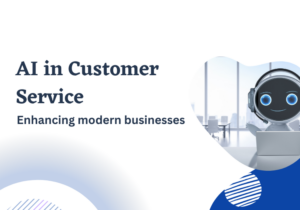Voice of Customer Analytics: Everything You Need to Know
Understanding your customers’ problems and hearing the voice of customer analytics is important to get more repeat business and improve your bottom line.
Are you ready to harness the power of customer feedback to drive your business forward? In today’s rapidly changing business landscape, staying competitive and exceeding customer expectations is more crucial than ever.
According to a recent survey by Salesforce, “A significant 88% of customers believe that the quality of the experience offered by a company is equally crucial to the products or services it provides.”
This is where Voice of Customer (VoC) analytics steps in as your secret weapon.
If you’re curious about VoC analytics, you’ve landed in the right spot. In this article, we’re here to explain what VoC analytics is, where it gets its data, and how to create a smart VoC analytics plan.
In this guide, you’ll find:
- What is VoC analytics?
- Where does VoC data come from?
- How VoC analytics inform business strategy.
- Building a successful VoC analytics strategy.
- Enthu.AI help you gather the right VoC data.
- FAQs
This journey will show you the amazing benefits of truly understanding your customers in a world where their experience matters the most. So, let’s dive in and explore the world of VoC analytics together.
A. What is voice of customer analytics?
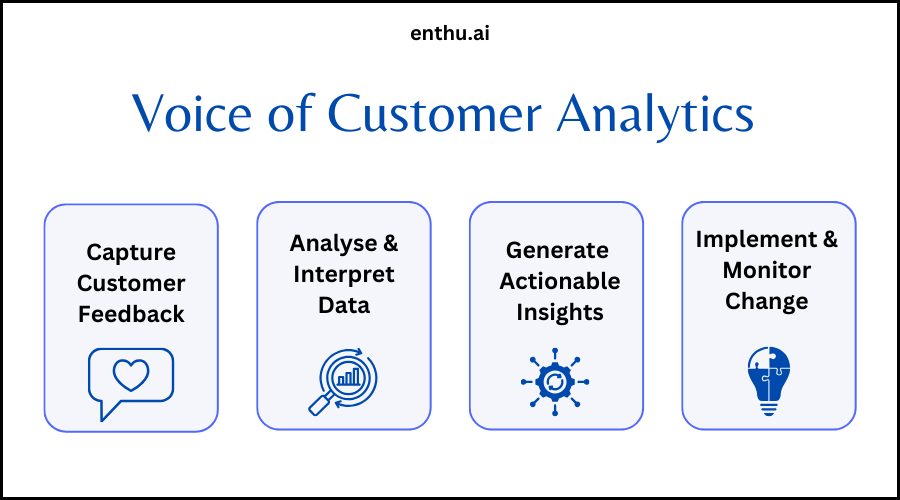
Voice of Customer analytics(VoC), is a systematic process of collecting, analyzing, and interpreting customer feedback and data to gain a deep understanding of customers’ perceptions, preferences, and experiences.
It encompasses various data sources, from customer surveys to online customer reviews to social media interactions and more.
The primary goal of VoC analytics is to use these insights to improve customer satisfaction, loyalty, and overall business performance.
Whether it’s streamlining customer support processes, refining product development, or personalizing marketing efforts, VoC analytics is a compass guiding businesses toward improved decision-making and enhanced customer satisfaction.
B. Where does VoC data come from?
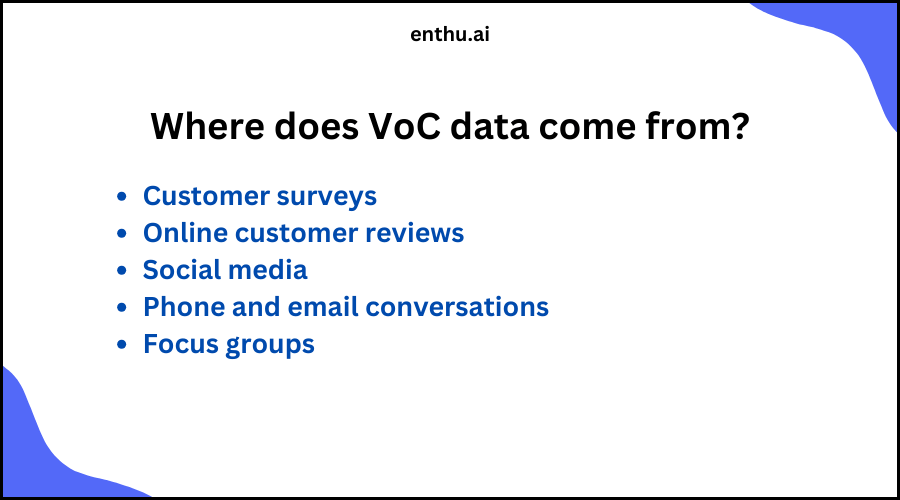
Collecting VoC data from the following sources helps businesses gain a holistic understanding of their customers’ needs, preferences, and satisfaction levels.
This information can inform product and service improvements, marketing strategies, and overall customer-centric decision-making.
1. Customer surveys
Customer surveys are structured questionnaires or feedback forms designed to collect customer information directly.
They can be distributed through various channels, including email, website pop-ups, and mobile apps.
Surveys typically contain questions related to a customer’s experience, satisfaction, preferences, and suggestions.
The data collected from surveys is quantitative and provides businesses with a systematic way to understand customer sentiment and preferences.
2. Online customer reviews
Online customer reviews are comments and ratings that customers leave on platforms like Yelp, TripAdvisor, Google, Amazon, and various other review sites.
These reviews provide unfiltered and publicly available insights into what customers like or dislike about a product or service.
Analyzing online reviews can help businesses identify common themes, concerns, and positive aspects important to their customers.
3. Social media
Social media platforms such as Twitter, Facebook, and Instagram are rich sources of VoC data. Customers share their opinions, feedback, and experiences on these platforms, often in real-time.
Monitoring social media for mentions, comments, and messages related to a brand or product can help businesses keep track of what customers are saying and engage with them directly.
Social media data can be both qualitative (text-based comments) and quantitative (e.g., likes and shares).
4. Phone and email conversations
Customer interactions with customer service representatives, whether through phone calls or email, provide a valuable source of VoC data.
These conversations may involve inquiries, complaints, or feedback.
Speech analytics software can be used to transcribe and analyze these conversations for trends and patterns.
Businesses can gain insights into common customer issues, sentiments, and areas that may require improvement.
5. Focus groups
Focus groups involve bringing together a small group of customers to discuss their opinions and experiences in a more structured and interactive setting.
These discussions allow businesses to gain deeper insights into customer preferences, motivations, and the nuances of their feedback.
Focus groups provide qualitative data that can complement the quantitative data gathered through surveys and other methods.
C. How VoC analytics informs business strategy?
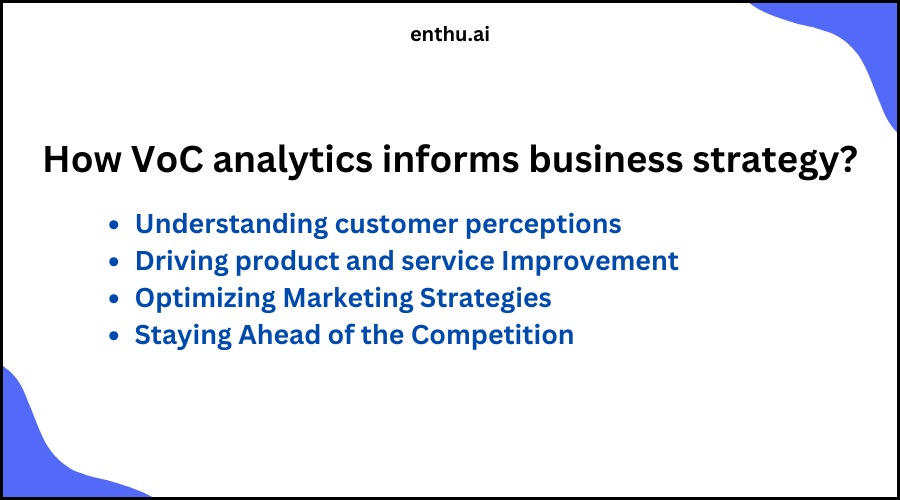
VoC analytics plays a crucial role in shaping a company’s business strategy. Here’s how it does so:
1. Understanding customer perceptions
VoC analytics helps companies gain a deeper understanding of how customers perceive their brand. It involves the analysis of customer feedback, reviews, and sentiments.
This data provides insights into the strengths and weaknesses of your products or services from the customer’s perspective.
For example, it can reveal if customers see your brand as reliable, innovative, cost-effective, or lacking in certain aspects. This understanding is crucial for branding and positioning strategies.
2. Driving product and service Improvement
VoC analytics is a valuable tool for collecting and analyzing customer feedback. It allows businesses to pinpoint areas that need improvement in their products or services.
This feedback-driven approach ensures that changes are made based on actual customer needs and preferences rather than assumptions.
3. Optimizing Marketing Strategies
VoC analytics can also help companies understand which marketing strategies are effective in reaching and engaging their target audience.
By analyzing customer feedback and sentiment related to marketing campaigns, companies can gain insights into what resonates with customers.
This data-driven marketing approach leads to a better return on investment and helps tailor marketing efforts to customer preferences.
4. Staying Ahead of the Competition
Understanding what your customers want and need is a strategic advantage that can help you outperform your competitors.
By actively listening to customer feedback and addressing their pain points, you can offer solutions and experiences that set you apart in the market.
Additionally, VoC analytics can help you identify gaps in the market that competitors may not be addressing, allowing you to seize opportunities and stay ahead of the competition.
D. Building a successful VoC analytics strategy
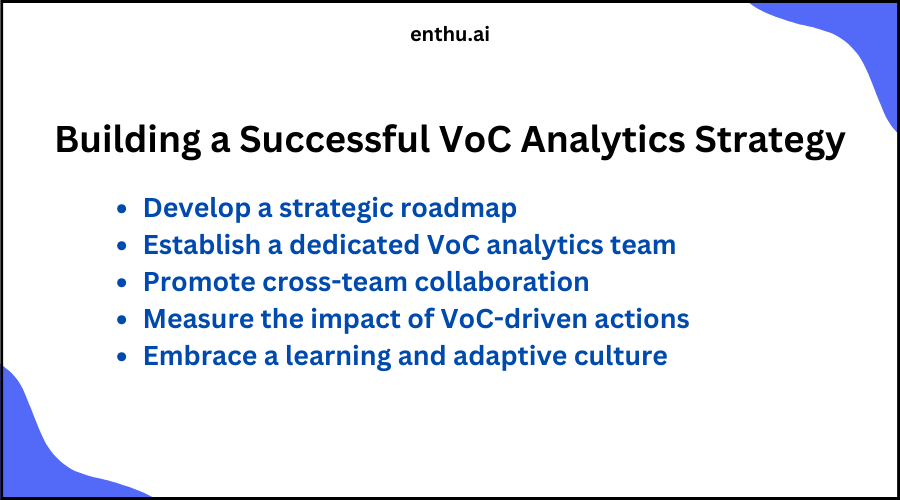
To make the most of VoC analytics, businesses should consider the following strategies:
1. Develop a strategic roadmap
it’s crucial to start with a well-defined strategy to maximize the benefits of Voice of Customer (VoC) analytics.
Begin by setting clear objectives for your VoC analytics program. Identify the key performance indicators (KPIs) that are most relevant to your business goals.
Outline a strategic roadmap for data collection, analysis, and implementation.
This roadmap will serve as a guide for how your organization plans to leverage VoC data to enhance customer experiences and drive business outcomes.
2. Establish a dedicated VoC analytics team
Building a dedicated team or department responsible for VoC analytics is essential.
This team should include data analysts, customer experience experts, and technology specialists.
Data analysts are crucial for gathering, processing, and deriving insights from VoC data.
Customer experience experts can provide valuable insights into understanding customer behavior, while technology specialists can ensure the effective implementation of analytics tools and technologies.
3. Promote cross-team collaboration
Encouraging collaboration between various departments, such as marketing, customer service, and product development, is vital for a successful VoC analytics strategy.
Sharing VoC insights across teams fosters alignment of strategies and helps in improving overall customer experiences.
Marketing teams can use customer feedback to refine campaigns, customer service teams can address issues proactively, and product development teams can make data-driven improvements to products or services.
4. Measure the impact of VoC-driven actions
Continuously monitoring the impact of changes made based on VoC insights is a critical step.
It’s important to assess whether customer satisfaction and loyalty are improving due to these actions.
Additionally, track whether there are measurable improvements in products and services.
By measuring the effectiveness of your VoC-driven initiatives, you can make data-informed adjustments to your strategy as needed, ensuring that it remains aligned with your business goals and customer expectations.
5. Embrace a learning and adaptive culture
VoC analytics is an ongoing process, and customer preferences and expectations can evolve. Embrace a culture of continuous learning and adaptability.
Be open to feedback and view it as an opportunity to learn and grow.
Your VoC analytics strategy should be flexible, allowing adjustments in response to changing customer needs and market dynamics.
This adaptability is key to staying relevant and competitive in a dynamic business environment.
E. Let Enthu.AI help you gather the right VoC data
Enthu.AI offers comprehensive VoC analytics solutions through its Conversation Intelligence, Speech Analytics, Quality Assurance, and Call Monitoring features.
These tools give companies a 360-degree view of their performance and the data they need to drive continuous improvement.
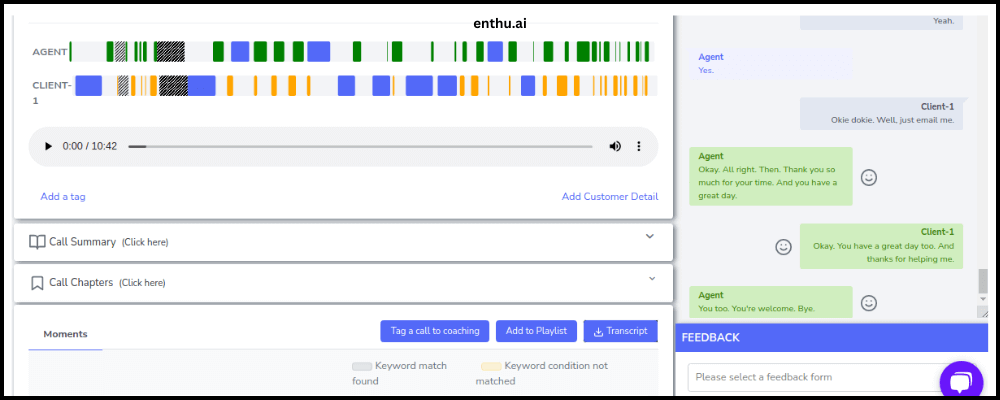
Whether it’s analyzing customer interactions, monitoring call quality, or coaching agents for better service, Enthu.AI can be your trusted partner in the VoC analytics journey.
Conclusion
Harnessing the power of Voice of Customer (VoC) analytics is no longer an option but a necessity for businesses striving to thrive in today’s competitive and customer-centric landscape.
VoC analytics not only helps you understand how your customers perceive your brand but also drives tangible improvements in products, services, and marketing strategies.
It empowers you to outperform your competition by staying attuned to customer needs, addressing their pain points, and identifying untapped market opportunities.
This journey towards understanding your customers and exceeding their expectations is a continuous one, and by embracing the power of VoC analytics, you ensure that you’re always on the right track to success.
FAQs
1. What is the primary purpose of Voice of Customer (VoC) analytics?
The primary purpose of VoC analytics is to collect and analyze customer feedback and data to gain a deep understanding of customers’ perceptions, preferences, and experiences.
This information is used to improve customer satisfaction, nps, and overall business performance.
2. How can businesses effectively gather VoC data?
Businesses can gather VoC data from various sources, including customer surveys, online customer reviews, social media interactions, phone and email conversations, and focus group discussions.
Using data analytics tools and platforms can help streamline the process.
3. Why is it important for businesses to have a dedicated VoC analytics team?
Having a dedicated VoC analytics team ensures that there are experts in charge of collecting, analyzing, and interpreting customer data.
This team can focus on aligning strategies and making data-driven decisions, leading to better customer experiences and business outcomes.

